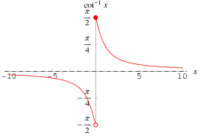You are using an out of date browser. It may not display this or other websites correctly.
You should upgrade or use an alternative browser.
You should upgrade or use an alternative browser.
Calculus 1 question
- Thread starter Steven G
- Start date
Dr.Peterson
Elite Member
- Joined
- Nov 12, 2017
- Messages
- 16,619
How about the floor function?Can anyone think of a non-piecewise function that has a jump discontinuity?
Steven G
Elite Member
- Joined
- Dec 30, 2014
- Messages
- 14,561
I would say no, as it is defined as a piecewise function. I too thought of that but rejected it. For the record I have a very nice function. Nothing strange or fancy just a very clean looking function.How about the floor function?
Should I post it now or does anyone want more time?
Dr.Peterson
Elite Member
- Joined
- Nov 12, 2017
- Messages
- 16,619
Actually, have you tried formally defining the floor function piecewise? (It has infinitely many pieces!) I agree that it seems inherently piecewise; but I imagine that could be said about anything with a jump.I would say no, as it is defined as a piecewise function. I too thought of that but rejected it. For the record I have a very nice function. Nothing strange or fancy just a very clean looking function.
Should I post it now or does anyone want more time?
The inverse secant is inherently "in pieces", and I imagine you might be able to construct a jump discontinuity from that. In fact, one version of the inverse cotangent in itself has a jump, by virtue of the choice of range:

Steven G
Elite Member
- Joined
- Dec 30, 2014
- Messages
- 14,561
f(x) = e^(1/x)/[1+e^(1/x)]
This will be my favorite function for a while.
https://www.wolframalpha.com/input/?i=graph+f(x)+=+e^(1/x)/[1+e^(1/x)]
This will be my favorite function for a while.
https://www.wolframalpha.com/input/?i=graph+f(x)+=+e^(1/x)/[1+e^(1/x)]
Dr.Peterson
Elite Member
- Joined
- Nov 12, 2017
- Messages
- 16,619
But that's undefined at x=0; I could be wrong, but I think of a jump discontinuity as being like all the other examples, which are defined at that point.f(x) = e^(1/x)/[1+e^(1/x)]
This will be my favorite function for a while.
https://www.wolframalpha.com/input/?i=graph+f(x)+=+e^(1/x)/[1+e^(1/x)]
For example, MathWorld implies this:
A real-valued univariate function f=f(x) has a jump discontinuity at a point x_0 in its domain provided that ...
does arctan(1/x) fit?
 www.wolframalpha.com
www.wolframalpha.com
graph f(x) = arctan(1/x) - Wolfram|Alpha
Wolfram|Alpha brings expert-level knowledge and capabilities to the broadest possible range of people—spanning all professions and education levels.
Dr.Peterson
Elite Member
- Joined
- Nov 12, 2017
- Messages
- 16,619
[MATH]\frac x {\sqrt{x^2}}[/MATH]
These both share the difficulty that they are not defined at x=0; if you allow a jump discontinuity to be like that, then it's a lot easier to find examples.does arctan(1/x) fit?
graph f(x) = arctan(1/x) - Wolfram|Alpha
Wolfram|Alpha brings expert-level knowledge and capabilities to the broadest possible range of people—spanning all professions and education levels.www.wolframalpha.com
My suggestion in #5 is identical to #11 but with a hole filled in (and that's the reason for that choice of range for arccot).
LCKurtz
Full Member
- Joined
- May 3, 2019
- Messages
- 475
Just to throw in a bit of uncertainty. I'm not convinced that it is a standard definition that a piecewise continuous function on an interval must be defined at each point of the interval. Look here for an example of that:
I don't know where to look for an "official" definition which is generally agreed.
I don't know where to look for an "official" definition which is generally agreed.
Dr.Peterson
Elite Member
- Joined
- Nov 12, 2017
- Messages
- 16,619
Just to throw in a bit of uncertainty. I'm not convinced that it is a standard definition that a piecewise continuous function on an interval must be defined at each point of the interval. Look here for an example of that:
I don't know where to look for an "official" definition which is generally agreed.
I never said I have no uncertainty about this!
But to be technical, the question is not about the definition of "piecewise continuous", but of "jump discontinuity" in a "non-piecewise" function (that is, not defined by pieces); and the initial question implied that what was asked for is rare. That subconsciously, at least, led me to ignore the relatively common situation like x/|x|, and consider only functions that are discontinuous only because of a jump, and not (also) because of a hole. Then I found one definition that agrees with that impression.
There are lot of definitions (especially of relatively informal terms like "jump discontinuity") that are not quite clear.
